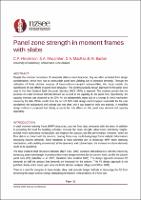| dc.contributor.author | MacRae, Gregory | |
| dc.contributor.author | Macalister, Ed | |
| dc.contributor.author | Henderson, Cameron | |
| dc.date.accessioned | 2024-07-01T02:01:21Z | |
| dc.date.available | 2024-07-01T02:01:21Z | |
| dc.date.issued | 2024-04-09 | |
| dc.identifier.uri | https://repo.nzsee.org.nz/xmlui/handle/nzsee/2752 | |
| dc.description.abstract | Despite the common occurrence of composite slabs in steel structures, they are often excluded from design considerations, which may lead to undesirable panel zone yielding due to increased demands. Through the utilisation of finite element analyses of beam-column-slab-joint subassemblies, this study models the significance of slab effects on panel-zone behaviour. The existing capacity design approach for the panel zone used in the New Zealand Steel Structures Standard (NZS 3404) is assessed. The analysis proved that the presence of a slab increased both the demand on the panel zone and the capacity. Specifically, the capacity increase was observed to be 20% for the subassembly tested due to a change in yield mechanism caused by the slab. While the current NZS 3404 design method appeared reasonable, its application of underlying principles was found to be incorrect and lacking clarity. A modified design method is proposed that accurately and clearly accounts effects on the panel zone due to the slab. These findings hold significant implications for practitioners and researchers seeking to optimise structural designs and attain superior outcomes in complex seismic environments. | |
| dc.language.iso | en | |
| dc.publisher | New Zealand Society for Earthquake Engineering | |
| dc.relation.ispartofseries | 2024;36 | |
| dc.subject | Seismic performance, risk mitigation and resilience of new and existing structures | |
| dc.title | Panel Zone Strength in Moment Frames with Slabs | |
| dc.type | Article | |

